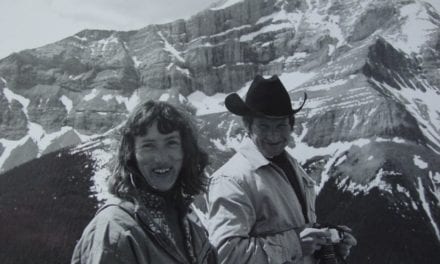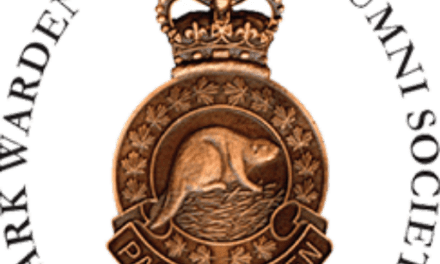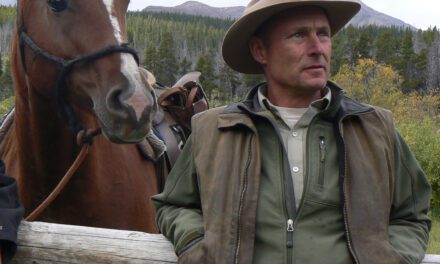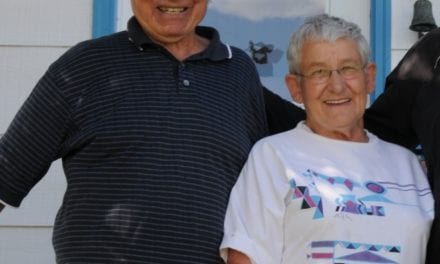“Growing up on a farm, did you have horse experience?
(15:02) At the Fairholme ranch we had the horses there. The Superintendent had his horse and I had a couple of horses, a saddle horse and a packhorse. Actually before I was in the warden service, I was in the RCMP, so we had the horse training.”) I went from the RCMP to the provincial parks. I got a good offer there and then decided to maybe go look at some bigger stuff. I had the horse training in the RCMP, mind you it was English riding, but there is not much difference. The cowboys tend to make you believe there is lots of difference, but there isn’t. A horse is a horse.
(16:01) Yeah, I moved into the town site because everything got amalgamated. Shortly thereafter there was a fellow there ‘Jim Robertson’ who used to do bears, but he had cancer. In fact, I took the last backcountry trip with him into Shadow Lake. We stayed in the cabin and he was coughing, etc, etc and I ended up with a wood tick that he helped me get out. That last trip on horseback, we went into Shadow Lake and over to Red Earth, then over to Kootenay Park for a ways and then came back. I was with him on his last horseback ride in the backcountry. He was the bear expert and after he couldn’t work anymore I took over the bears. I did that for I think about three years, three and a half years. So I dealt with rotten bears, mostly by myself, because in (those) days that’s how it was done.
“Was that time of Whiskey Creek?” (In 1980, three bear attacks occurred over a short period in the Whiskey Creek area of Banff National Park.)
Oh, no that was before.. The time at Whiskey Creek was just before I left for Halifax. No, that was in the mid 1970s or maybe 1973/74, something like that…I was looking after bears when this biologist got mauled. (In 1973, Wilf Etherington, a biologist for the Canadian Wildlife Service was mauled by a grizzly. Wilf Etherington…Actually I caught that same bear the previous fall. He had broken into what is now Castle Junction, at the café which was then Eisenhower. He had broken into there and smashed everything inside. I went down there and I actually trapped him right away. It was late in the fall and we took him into a back valley that he couldn’t get out of until spring because it was snowed in already. The next year they caught him and he mauled this one fellow. It was a sad situation. There is a lot to that story which we will keep to ourselves…Yeah, he got his head bitten off. Yeah, well…he was the one who had captured the bear, he was involved in the tranquilizing of the bear. He didn’t go after the cameraman, he went after the fellow that put him to sleep. I really think that bears know that you have handled them, they must. Well, at the time we were using anectine, and of course the bear is totally awake, but he can’t move. What happens is the synapses in the nerves are neutralized. So he can see everything, the bear, but he just can’t do anything about it. The stuff we used after, sertraline, and all this kind of stuff, well that was better because the bear was asleep.
“After your work with the bears, were you still in Banff?”
(21:03) Then I applied for an Area Manager job because the other fellow retired and I got that job in Banff. Which then that turned out to be Assistant Chief Warden. But in between there I went to Lake Louise for a year, or a year and a half…Then when Andy Anderson decided that he wanted to go and do highway stuff, I ended up being the acting Chief Warden for a year. About six months later, I applied for a job in Halifax and got it. We spent the next nine years in Halifax.
“That would be quite a change from Banff.”
Oh yeah, I enjoyed it. It was totally different. I was the Regional Warden Specialist, is what they called it. So I was coordinating all the wardens in the parks with the training and you name it, hiring, competitions and all that stuff, doing human resources. Then if they needed some help on long weekends, they would ask me to come out…and I would go out and spend time in the parks, talk to the chiefs, see their systems and help them out. If you had a little more experience it helps, you’ve got different ideas. And they were all open to it which was really, really good. We had some good times out there. I think that was probably the best part of my whole career because we all got along. We used to have the craziest parties. Everyone would come in from the field for our semiannual meeting and part of that would be to come to our place and have a big lobster feed and then we would have a big party! Oh, there are some stories! But you know, that is how you build (camaraderie)…There was no bickering, the egos all got left at the door…
(23:59) One of the things there that I really enforced was transfer ability across the country. In fact, on one case it was appealed…based on the (belief) that local people should get preference. They said that somebody coming from Alberta…that ended up being the Chief Warden in Gros Morne (shouldn’t have gotten the job), they didn’t think that was fair. But because he was chief here, we just did a lateral transfer. It went to appeal and the Appeal Court ruled in my favor. Under the constitution you can work (anywhere), you can’t be discriminated against…That was a major coup too, to get that entrenched. We did a lot of lateral transfers, much, much more than in this end of the country where a lot of people start in one place and ended up in one place. I don’t think there are too many people who did that, most of them probably worked in three or four different parks.
(25:35) We drove across the country when we got transferred out there and that was an experience. Boy, this country is big! A long drive… I have two daughters. I have a daughter from my first marriage, she lives in Banff and then I have a daughter from my second marriage. When we went east, there were no children, we had a dog though. It was kind of funny, on our route we stopped at the Great Lakes, in one of the picnic areas there for a bit of a rest and our mini black lab decided he was going to roll in some fish guts. In a car, “Oh, God!” We didn’t realize it until we were going, it smelled! It was a nine day trip across the country. Coming back we drove back as well, but we drove the southern route, the I90, then up to Winnipeg and then out this way. We stopped in Waskesiu Lake and visited there. You know, when you are in the warden service, you got friends all over the place. I still keep track of the people in the east…most of them are retired now. I’ve got some good friends, we meet there and some of them are out this way now. One fellow got transferred from PEI park when I was in there for a summer. He transferred to Wood Buffalo/Fort Chip and we have kept in touch ever since…He doesn’t live in Fort Chip anymore, he is retired. He lives in, what’s that town up there south of Fort Chip? It’s where one of the hockey players is from…Lac la Biche.
“So after nine years, you came back to Banff?”
(28:06) I went back to Yoho. The reason why is we were out there in the east and I wanted my daughter to get to know the family, because we had no family out there. That is the only reason we came back. She was born in Halifax?”) Then afterwards she went to university at Dalhousie. She wanted to go back to Halifax to go to university which she did and then she did her masters in Calgary…She is living in Nanaimo now, she is a social worker. My other daughter, she is in business, in real estate… (The interview paused to meet Marion, Paul’s wife.)
(29:48) We haven’t got into some of these real neat stories yet, which we will…Then I retired. I retired In 1997, but in late 1996 I had a heart attack, a bad one, at 3:00 in the morning. I survived that one. My cardiologist said it was a stress related heart attack. We were going through all this reorganization and all this stuff and the stress just took its toll. So he decided that I wasn’t going back to work. Then I decided, “Well, that’s a good idea because I don’t think I could after that episode.”
“When you were at Yoho, were you the Chief?”
(31:01) Yes. I was also in PEI before we came to Yoho…that was on an assignment because of circumstances. They needed somebody to go in there and do certain things which I will leave unnamed. I was in there for a summer. I went in the beginning of May and then I hired a replacement Chief there from a competition, when he got there I went back to Halifax and then came to Yoho.
“So how many years would you have been in Yoho?”
Six, somewhere in that neighborhood, I retired in 1997.
“Are there any wildlife stories that stick out in your mind?”
(32:36) Lots, especially working with bears! I remember one time when I was looking after bears, it was myself and Scott Ward, and we were in Johnson Canyon Campground. We were called because there was a grizzly in there. So we went down, I grabbed a trap, he grabbed a cage. We loaded up and went down there and it ended up that night, there were six grizzly bears in the campground! Of course we had the campground staff going around telling people to get their food out of there and all the rest of it. It must have been about 1:00 in the morning, and we had caught a couple of bears already. They were in the cage and the cage was starting to fill up! We had tranquilized them…We could hear this awful scream and we were worried because there was a big grizzly that we were watching and were trying to get if we could. We went to investigate it and there were paw prints over top of the sleeping bag and they were huge paw prints. I guess this bear, we must have scared it (because) it ran right over top this one fellow…the funny part was by the time we got there, him and his buddy were packed up, ready to leave! He was showing me, he had this sleeping bag, “See that!” And there was a huge foot print right on top of it. He thought he was going to be dinner. We ended up, I think it was four bears we got out of there that night. But about 2:00/2:30 people were packing up and leaving. But what else are you going to do? You can’t just shoot them. It’s not the bears fault.
(35:07) There is another good story I’ve got which again was at Johnson Canyon, this time in the picnic area. We got a call, there was a bear and actually what he was doing was he was chasing people away from the barbeque and grabbing the food. We got there and I took a trap with me. We usually grabbed a trap because you’ve got to put him somewhere…There was a fellow in picnic shed barbequing and him and this bear (had a standoff). He was defending his food and the bear wanted it when I got there. I told this fellow to back off and I was just going to put a dart into this bear. I had a good idea how big this thing was and I had the dart all done up. I hit the bear with the dart. I was trying to get him in the neck, but I think I must have got him in the back of the head because the bear went down immediately and that’s unheard of. Really, it’s five minutes before he goes down. I got the gate up, grabbed a hold of this bear which was a young bear, maybe a two year old…I had grabbed a hold of him and was hauling him into the truck and the next thing I know, I was getting clawed! He was clawing me like crazy, he ripped my shirt and everything else. I finally got him into the trap and put the door down. The dart had fallen out. So I took the dart and I was taking it apart to get the explosive out and (realized) it hadn’t gone off. It had just knocked him out, but he came to! That was a good story because this fellow that was doing the barbequing took pictures all along. I asked him at one point, I said, “Can you give me a hand and get that door down?” He said, “I am taking pictures!” Yeah, that was a good story. I think it was about a two year old, first year loose…
(38:01) There are a lot of bear stories from Tunnel Mountain Campground and places like that. It was exciting times. That one year I think I was hitting about 100 bears and handling them. It was about, I would say, 65% black and the rest grizzlies. But after you do it so often you get kind of good at guessing weight because that was very important with anectine, you had to be quite accurate otherwise the animal would die.
“Are there any rescue stories that stick out in your mind?”
(39:05) Well, a number One was at Yamnuska, we went up and he (the climber had) got tangled up about three quarters of the way down. We had to pull him off, we pulled him off with the helicopter. In those days, we weren’t into yet, it was starting to evolve. We put the body into a body bag, hooked it on to the bottom of the helicopter, like he had the rope hanging down. When the helicopter came down to where the ambulance was this body was swaying probably 150 feet this way and 150 feet that way. We couldn’t really grab it because he would just take you and send you flying. That was kind of a horror story to try and get that body off without banging it up…but in them days what (could) you do?
(40:24) But there are some good practice rescue stories. This was in the early years of sling rescue and of course we had a devil of a time trying to convince the Department of Transport that this was the way to go, that was huge, huge problems. But we just marched on. We did a practice and I guess the Superintendent was told we had to cut back on that because chances of an accident were too high. There was this fellow who was being slung past the administration building and the Superintendent was in the conference room conducting a meeting and there was this fellow going by…on the rope looking in at him…I think the Superintendent was Steve Kun. He looked out and he just about had a heart attack! That’s kind of an interesting story. You know, the gory stuff of rescues, I don’t want to get into because that is kind of hard on the system…
(41:47) One of the other times, we used to practice at the airport down here in Banff. The pilots weren’t really that great in how this was done at that time, none of them. We were practicing and we had one of the newer helicopter pilots. He wasn’t new, he had lots of hours in, but he hadn’t done too much of this (sling rescue) stuff…One of the fellows was underneath and the helicopter came in a bit low and he got dragged through the bush this fellow and then he had to run like heck because the helicopter pilot was probably about five feet too low coming in for the landing! He was coming in this way (demonstrating), he wasn’t coming this way and then down. So this guy was running for his life, being dragged by the rope…I think over time that was perfected and we got sanctioned to do this kind of stuff with the helicopter. We tested our own pilots. It was quite a rigorous testing program and you know we probably had the best pilots available for that. We trusted them because we knew that they were good because we had put them through all kind of tests. They were all flying tests, (for example) you stack one 45 gallon drum on top of another one and stuff like that.. definitely precision.
(43:41) It was a steady stream of rescues. There were so doggone many that you don’t even remember most of them.
(43:48) When I was in Banff, probably when Terry Skjonsberg was probably first year seasonal…his father (Earl) was the dog master before that. When Earl had his dog I used to go out with him. I used to be the quarry and run away and stuff like that. I had the arm on and everything else. We got to be quite good friends because we were always working together like that. But his son became a seasonal warden. We left Banff early morning, we usually started at about 7:00 in the morning because we were looking for illegal campers and booting them out. We saw this fellow down at the canal above the powerhouse on the uphill side. This fellow was in his sleeping bag and I said to Terry, “Let’s put the run on this fellow.” We approached him and I said, “There is something fishy here, I just don’t quite feel right about this whole situation.” I said, “You go wait over there, don’t come close to me. We will separate incase something happens.” Just as I got to him, probably about five feet away, I could see this tugging in the sleeping bag, so I jumped on top of him right away. Terry thought that I was going to pound the heck out of him! He didn’t know what was going on. I unzipped the thing (the sleeping bag) and pulled out a .30-30 loaded. He admitted to the police that if he had woken up earlier he would have shot us. He was on parole, he had stolen the rifle from his parole officer. He wasn’t even supposed to be here, (he was) a fellow about 18/19 years old. That was a close call, but you know sometimes you sense this. I had a built in sense because of the (police) training. I kind of sensed that something wasn’t quite right and sure enough it wasn’t. Terry said, “How did you know?” I said, “I didn’t. I just had this feeling.” I’ve had that a number of times when things felt kind of strange.
(46:33) This is why the whole episode with the firearms is kind of a farce. Sooner or later it was going to happen, they were going to be armed. There is no doubt about it. It was just that senior management dug their heels in and destroyed the warden service as a result. A lot of people actually blame the fellow who took the cause up, but I don’t blame him. (In 2000, Banff Park Warden, Douglas Martin filed a federal Labor Code Complaint arguing that, without a side arm, he was being placed in situations of potential danger without the necessary protective equipment. Remington, Robert. “Men for the Mountains.” Discovering Alberta – A Calgary Herald Magazine Series.)
I think he was just doing what should have been done…I can see why a lot of then wardens didn’t want to be involved in that because they didn’t want to be involved in law enforcement. They wanted to be wardens… You can’t be one and not the other because, really, under the (National Parks) Act ,that is their main job. Yeah, it was a sad day when all this happened. It is a matter of senior management (not) considering the facts. They had their own twisted facts, but they have never been in the field, they had never been in a situation. So how would they be able to (know)? They ignored the advice that was given. In fact there were studies done by experts (about whether or not) the wardens should be armed and every one of them said yes, and they were outsiders. Parks paid for it, but they ignored it, the senior management ignored it! Politically, there were all these statements, “You are going to start shooting tourists.” And all the rest of it. Has anybody been shot? No. Well, that has been a sore point with me. I have a real axe to grind with senior management in parks over that. They all know who they are and some of them I’ve accosted, I’ve basically told, because I say what I think, I am not afraid. One of the fellows said, “You’ve got to be careful.” I said, “What are you going to do, fire me?” I said, “I know too much.” Well, when you’ve got 30 years in, what are you going to do? I can say, “Well, good-bye. I’ve got enough years.”



